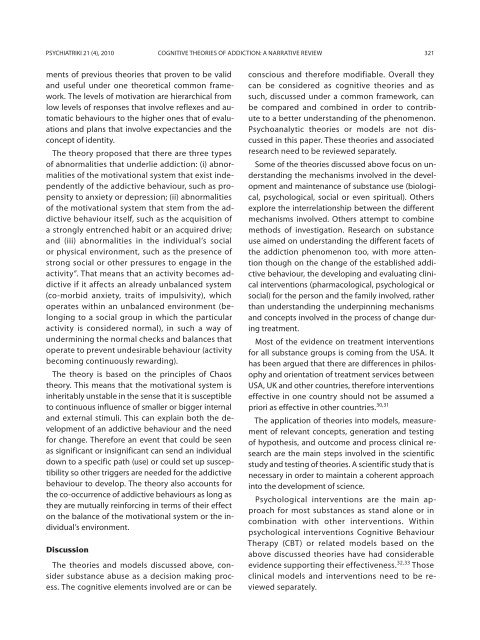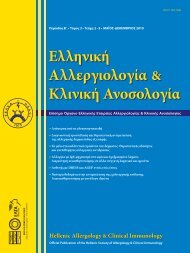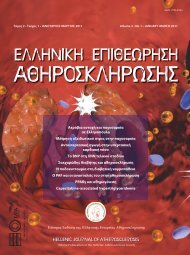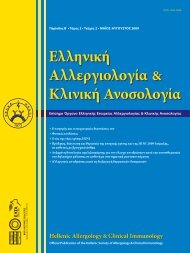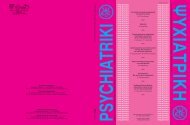320 C. Kouimtsidis PSYCHIATRIKI 21 (4), 2010Neuropsychology models (spreading activationmodels of memory, schema theory, implicit cognitionand neural network theory) have been adopted.The emerging theory proposes that addiction isthe result of biases that affect conscious functions,such as beliefs, attention and memories, as well asunconscious processes in information recall frommemory. 25It is hypothesised that representations of the behaviourare "linked" in long-term or semantic memorywith propositions about outcome (e.g. relaxing,risk, etc). Such links may be created by direct experiencebut are not likely to be solely determined bythis, and may be formed by abstraction of informationfrom the environment. The motivational significanceof these associations is likely to be positiveand appetitive, consistent with experience in theearly stages of an addiction career and the initial effectsof the substance/behaviour. 26 These "semantic"links become strengthened and more tightlyconnected with repetition of behaviour. Over time,activation of one part of the "network" (e.g. alcohol-representations)automatically triggers propositionallinks in other parts (e.g. relaxation concepts)and vice versa. Thus, an accessibility bias forpositive information about the behaviour develops.Negative and behaviourally inhibiting informationmay be available, however, it is hypothesised thatthis information is less accessible and relies moreon effortful and non-automatic cognitive processes,therefore its moderating impact on behaviour iscompromised. 26The Excessive Appetites model of addiction 27 wasproposed to provide a coherent account of thewhole process of taking-up to giving-up any formof appetitive behaviour (even beyond drug abuse,such as gambling and eating) to which people canbecome severely attached with a negative effect onthem and those immediately around them. At thecore of the model is the development, within a socialcontext, of appetite-specific schemata, based on differentkinds of learning. Additional secondary processeshave an amplifying effect on schemata such as"acquired emotional regulation cycle", which includesabstinence violation effect (AVE), and "consequencesof conflict".Transtheoretical model of changeAn influential model that relies mostly on thechoice principle, but addresses how people modifyaddictive behaviour, is the Transtheoreticalmodel of behaviour change or Stages of Changemodel. 28 Although it is described as a model it proposesnew theory concepts, therefore it could beseen as a theory. The model focuses on this particularaspect of addiction rather addiction itselfand suggests that the process of recovery from anaddictive behaviour involves transition throughthe following stages: (i) pre-contemplation stage,in which no change is contemplated; (ii) contemplation,in which change is contemplated for thenear future; (iii) preparation, in which plans aremade on how to change behaviour in a definiteway; (iv) action stage, in which the plans are putinto action and change takes place; and (v) maintenance,in which the new pattern of behaviouremerges, establishes and is maintained. There is asixth stage, that of termination, which was addedmore recently and in someway overlaps with themaintenance stage. In this stage the individual hasadopted the new behaviour. The model proposesthat individuals can move forwards or backwards.The model has enjoyed popularity, whilst also receivingmajor criticism. The popularity might beexplained by the seemingly scientific approach of"diagnosing" the stage of change and the perceivedrelation to specific treatment plan, as well as theprovision of categories to classify people ratherthan use everyday language. 1 Motivational interventionsdeveloped in 1990’s are partly based onthe Stages of Change model and were describedas "Motivational Interviewing". 29 The criticism relatesto several aspects of the model, such as thedefinition and validity of stages, the proposed linearprogress through the stages, the inability ofthe model to account for the unconscious decisionmaking processes. 1PRIME theoryWest (2006) 1 proposed a new theory of addictioncalled PRIME, an acronym standing for the proposedfive levels of motivation: plans, responses, impulses/inhibitoryforces, motives, evaluations. This is asynthetic theory that aims to encompass all the ele-
PSYCHIATRIKI 21 (4), 2010 Cognitive theories of addiction: a narrative review 321ments of previous theories that proven to be validand useful under one theoretical common framework.The levels of motivation are hierarchical fromlow levels of responses that involve reflexes and automaticbehaviours to the higher ones that of evaluationsand plans that involve expectancies and theconcept of identity.The theory proposed that there are three typesof abnormalities that underlie addiction: (i) abnormalitiesof the motivational system that exist independentlyof the addictive behaviour, such as propensityto anxiety or depression; (ii) abnormalitiesof the motivational system that stem from the addictivebehaviour itself, such as the acquisition ofa strongly entrenched habit or an acquired drive;and (iii) abnormalities in the individual’s socialor physical environment, such as the presence ofstrong social or other pressures to engage in theactivity”. That means that an activity becomes addictiveif it affects an already unbalanced system(co-morbid anxiety, traits of impulsivity), whichoperates within an unbalanced environment (belongingto a social group in which the particularactivity is considered normal), in such a way ofundermining the normal checks and balances thatoperate to prevent undesirable behaviour (activitybecoming continuously rewarding).The theory is based on the principles of Chaostheory. This means that the motivational system isinheritably unstable in the sense that it is susceptibleto continuous influence of smaller or bigger internaland external stimuli. This can explain both the developmentof an addictive behaviour and the needfor change. Therefore an event that could be seenas significant or insignificant can send an individualdown to a specific path (use) or could set up susceptibilityso other triggers are needed for the addictivebehaviour to develop. The theory also accounts forthe co-occurrence of addictive behaviours as long asthey are mutually reinforcing in terms of their effecton the balance of the motivational system or the individual’senvironment.DiscussionThe theories and models discussed above, considersubstance abuse as a decision making process.The cognitive elements involved are or can beconscious and therefore modifiable. Overall theycan be considered as cognitive theories and assuch, discussed under a common framework, canbe compared and combined in order to contributeto a better understanding of the phenomenon.Psychoanalytic theories or models are not discussedin this paper. These theories and associatedresearch need to be reviewed separately.Some of the theories discussed above focus on understandingthe mechanisms involved in the developmentand maintenance of substance use (biological,psychological, social or even spiritual). Othersexplore the interrelationship between the differentmechanisms involved. Others attempt to combinemethods of investigation. Research on substanceuse aimed on understanding the different facets ofthe addiction phenomenon too, with more attentionthough on the change of the established addictivebehaviour, the developing and evaluating clinicalinterventions (pharmacological, psychological orsocial) for the person and the family involved, ratherthan understanding the underpinning mechanismsand concepts involved in the process of change duringtreatment.Most of the evidence on treatment interventionsfor all substance groups is coming from the USA. Ithas been argued that there are differences in philosophyand orientation of treatment services betweenUSA, UK and other countries, therefore interventionseffective in one country should not be assumed apriori as effective in other countries. 30,31The application of theories into models, measurementof relevant concepts, generation and testingof hypothesis, and outcome and process clinical researchare the main steps involved in the scientificstudy and testing of theories. A scientific study that isnecessary in order to maintain a coherent approachinto the development of science.Psychological interventions are the main approachfor most substances as stand alone or incombination with other interventions. Withinpsychological interventions Cognitive BehaviourTherapy (CBT) or related models based on theabove discussed theories have had considerableevidence supporting their effectiveness. 32,33 Thoseclinical models and interventions need to be reviewedseparately.
- Page 5: PSYCHIATRIKIQuarterly journal publi
- Page 9 and 10: PSYCHIATRIKI 21 (4), 2010 277Άρθ
- Page 11 and 12: PSYCHIATRIKI 21 (4), 2010 279Resear
- Page 13 and 14: PSYCHIATRIKI 21 (4), 2010 HOSPITAL
- Page 15 and 16: PSYCHIATRIKI 21 (4), 2010 HOSPITAL
- Page 17 and 18: PSYCHIATRIKI 21 (4), 2010 HOSPITAL
- Page 19 and 20: PSYCHIATRIKI 21 (4), 2010 287Resear
- Page 22 and 23: 290 P. TZOURAMANIS et al PSYCHIATRI
- Page 24 and 25: 292 P. TZOURAMANIS et al PSYCHIATRI
- Page 26 and 27: 294 PSYCHIATRIKI 21 (4), 2010Resear
- Page 28 and 29: 296 M. VLASSOPOULOS et al PSYCHIATR
- Page 30 and 31: 298 M. VLASSOPOULOS et al PSYCHIATR
- Page 32 and 33: 300 M. VLASSOPOULOS et al PSYCHIATR
- Page 34 and 35: 302 M. VLASSOPOULOS et al PSYCHIATR
- Page 36 and 37: 304 PSYCHIATRIKI 21 (4), 2010Resear
- Page 38 and 39: 306 H. LAZARATOU et al PSYCHIATRIKI
- Page 40 and 41: 308 H. LAZARATOU et al PSYCHIATRIKI
- Page 42 and 43: 310 H. LAZARATOU et al PSYCHIATRIKI
- Page 44 and 45: 312 H. LAZARATOU et al PSYCHIATRIKI
- Page 46 and 47: 314 H. LAZARATOU et al PSYCHIATRIKI
- Page 48 and 49: 316 C. Kouimtsidis PSYCHIATRIKI 21
- Page 50 and 51: 318 C. Kouimtsidis PSYCHIATRIKI 21
- Page 54 and 55: 322 C. Kouimtsidis PSYCHIATRIKI 21
- Page 56 and 57: 324 PSYCHIATRIKI 21 (4), 2010Specia
- Page 58 and 59: 326 B.J. HAVAKI-KONTAXAKI et al PSY
- Page 60 and 61: 328 B.J. HAVAKI-KONTAXAKI et al PSY
- Page 62 and 63: 330 B.J. HAVAKI-KONTAXAKI et al PSY
- Page 64 and 65: 332 PSYCHIATRIKI 21 (4), 2010Genera
- Page 66 and 67: 334 C.I. Istokoglou et al PSYCHIATR
- Page 68 and 69: 336 C.I. Istokoglou et al PSYCHIATR
- Page 70 and 71: 338 C.I. Istokoglou et al PSYCHIATR
- Page 72 and 73: 340 PSYCHIATRIKI 21 (4), 2010• 10
- Page 74 and 75: SUBMISSIONPapers either in English
- Page 76 and 77: ΥΠΟΒΟΛΗ ΕΡΓΑΣΙΩΝΟι
- Page 78: ΣΥΝΟΔΕΥΤΙΚΟ ΕΝΤΥΠΟ


